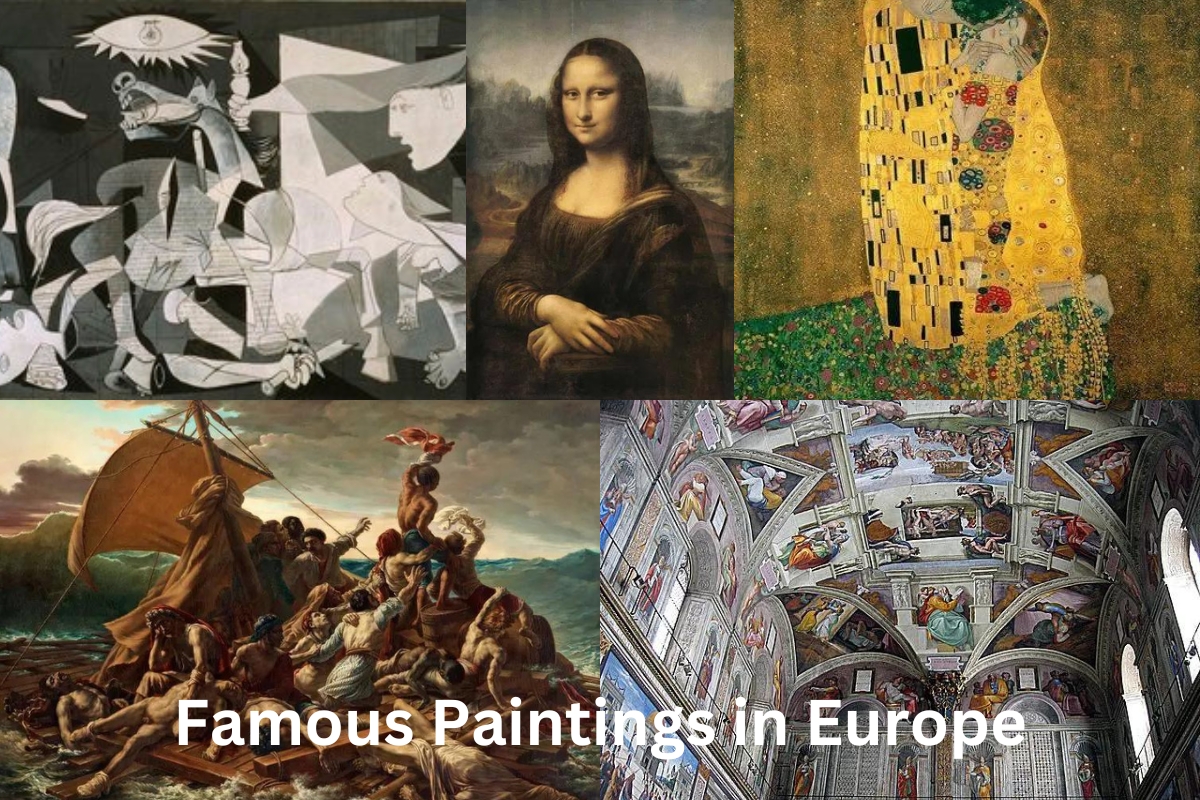Throughout history Europe has been the epicenter of western art, from the great Renaissance masters through to the modern art movement and beyond, it has been the dominant force in painting and sculpture.
If you are lucky enough to be traveling around Europe on a tour then you are in for a real treat as ever major city in Europe has numerous art galleries and museums filled with thousands of pieces of art.
Below are some of the most famous paintings in Europe that are on public display.
Famous Paintings in Europe
1. Guernica – Pablo Picasso

As a young man, Picasso was profoundly influenced by the atrocities of the Spanish Civil War, which broke out on July 17, 1936, when General Francisco Franco conducted a military coup against the Spanish Republic.
By the seventh month, Franco’s forces had established complete dominance over the country. Picasso informed his friend Joan Miró that he needed to express his displeasure after seeing the massive destruction caused by intense fighting in Barcelona during October 1936.
In a later letter, he declared, “I’m going to paint something unbelievable large… With every ounce of fury I possess, I will complete this. On December 2, 1936, he first sketched out ideas for the painting.
One of Picasso’s few works of really epic scale, Guernica has been called the artist’s “most powerful creation.”
The village of Guernica in the Basque Country of northern Spain was bombed by German planes under General Franco’s orders during the Spanish Civil War, inspiring the picture. It does an astonishingly effective job of depicting the horrors of war.
Picasso finished the painting in 1937, and it has since become one of his most recognizable pieces. It shows the brutality and death that are a part of battle.
The events depicted in the picture are not limited to a single conflict but rather encompass all that took place during the war.
It is currently housed at the Museo Nacional Centro de Arte Reina Sofía in Madrid, Spain.
2. The Kiss – Gustav Klimt
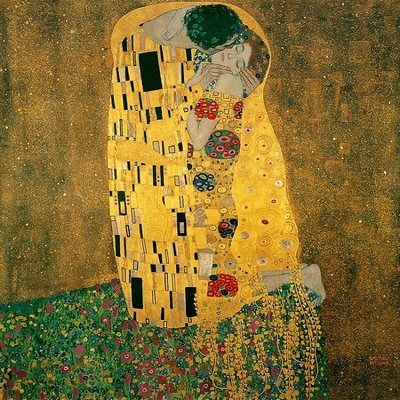
Known in its native German as Der Kuss, this painting was created in oil on canvas and features gold leaf, silver, and platinum accents. Dated to Klimt’s “Golden Period,” between 1907 and 1908, the painting represents a high point in his career.
The exhibition catalogue claims that its debut as Liebespaar occurred in 1908. (the lovers). The artwork depicts a pair in embrace, their bodies entwined in gorgeous robes embroidered in a manner influenced by both the contemporary Art Nouveau style and the earlier organic elements of the Arts and Crafts movement.
The painting is currently on display in the Austriaische Galerie Belvedere in Vienna’s Belvedere neighborhood, where it has gained international renown as a masterpiece of the Vienna Secession (the city’s version of Art Nouveau).
This painting is based on a story in Ovid’s Metamorphoses, and it has been speculated that Klimt portrayed the moment when Apollo kisses Daphne.
Klimt is credited by art historians with depicting the Orpheus and Eurydice legend. When Orpheus turns around to caress Eurydice, that’s the moment Klimt seems to be capturing.
According to the story, the lady’s semi-transparency in this piece of art represents her gradual disappearance.
If is on display at the Österreichische Galerie Belvedere in the Belvedere palace, in Vienna, Austria.
3. The Mona Lisa – Leonardo da Vinci
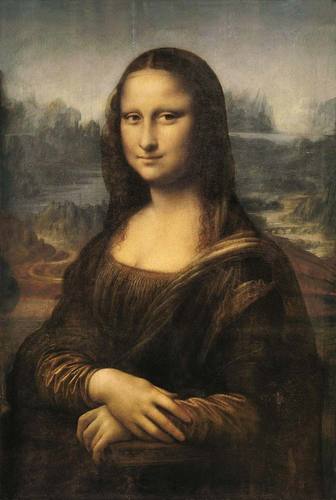
The works of Leonardo da Vinci have always been considered some of the most fascinating in the world. There have been countless reproductions of this painting in a wide variety of formats and sizes.
The Mona Lisa depicts Lisa del Giocondo, the wife of Francesco del Giocondo and the mother of the couple’s two children. Around 1503–1505, Leonardo da Vinci began work on it, and he finished it in 1519.
The Louvre Museum, founded in 1637 by King Louis XIV of France, is where the painting is currently on exhibit.
It’s incredible that this piece of art was finished 400 years ago and still looks so good now.
Art experts agree that it is a masterpiece, but the public didn’t learn about it until 1911, when an Italian employee named Peruggia stole it from the Louvre.
For Peruggia, an Italian patriot, the ideal scenario would be for the masterpiece to be displayed in an Italian museum rather than a French museum.
Hundreds of people wait in line each week to see it when it was returned to the Louvre after being lost for centuries.
4. Impression, Sunrise – Claude Monet
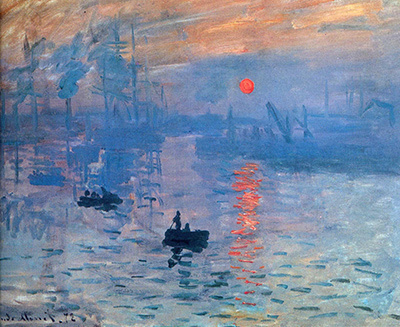
Claude Monet’s “Impression, Sunrise” is often cited as the reason for his widespread acclaim as the greatest French artist of all time.
Monet’s paintings were pivotal in the development of Impressionism in the mid-19th century.
Painting completed in 1872, it depicts a seascape landscape near Le Havre, France, where Monet is rumored to have spent time.
The painting’s famously soothing hues capture the peacefulness of dawn over a bustling port city around the time Monet painted it. Large vessels and barges are obscured by the morning fog.
The artwork centers on a cluster of boats, which may represent the simplicity of life that Monet admired or aspired.
It was exhibited alongside works by other, less well-known artists of its period, yet nonetheless managed to attract attention.
In addition to being regarded as one of Monet’s finest works, this picture has also been held in high regard as one of the finest examples of French art.
It is on display at Musée Marmottan Monet art museum in Paris, France
5. The Birth of Venus – Sandro Botticelli
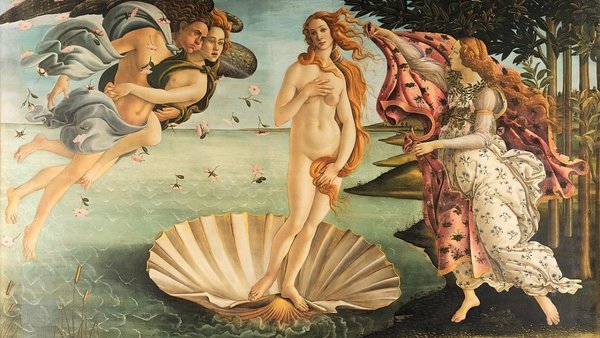
The painting known as “The Birth of Venus” was probably finished sometime in the mid-1480s. It depicts Venus emerging from the sea fully grown and then making her way to the beach to begin her life as a goddess (called Venus Anadyomene and often depicted in art).
The Uffizi Gallery in Florence, Italy is where the painting is kept.
The Primavera, another large mythological painting by Botticelli, is also on display in the Uffizi, but the two works cannot be separated. The Primavera and The Birth of Venus are two of the most famous paintings in the world and icons of the Italian Renaissance, with the former receiving more recognition than the latter.
They were the largest and most significant depiction of a naked female figure in Western art since classical antiquity, and they were unique in depicting issues from ancient mythology on such a grand scale.
It was once believed that a common Medici family member commissioned both works, however this is now shown to be incorrect.
Art historians have always been interested in them, and the main questions that arise concern such topics as whether or whether they were inspired by ancient art or the atmosphere of wedding celebrations, the influence of Renaissance Neo-Platonism, and the identities of the original commissions.
However, most art historians agree that unlike the Primavera, the Birth does not necessitate extensive research to comprehend its importance.
The film’s widespread appeal stems from the fact that despite its complexity, it provides an understandable albeit novel take on a well-known scene from Greek mythology.
6. The Night Watch – Rembrandt

The Night Watch, painted by Rembrandt in 1642, is widely considered to be his masterpiece.
There are three main reasons why this artwork is so popular.
The settings and scenes depicted in military paintings and group portraits have historically been somewhat static.
On the other hand, Captain Banning and his city militia guards are shown in The Night Watch getting ready to march out of their barracks.
Secondly, it’s massive dimensions (3.63 m x 4.37 m) and weight (337 kilos) make it stand out (including the frame.)
Thirdly, the scene is well-known for its dramatic use of light and shadow to highlight the scene’s central characters.
When he painted The Night Watch, at the height of his career, Rembrandt proved himself to be a true master of light, and the painting is now often considered to be his greatest.
Although it is technically part of the Amsterdam Museum’s collection, the Rijksmuseum displays it prominently because it is the museum’s most famous piece of art. One of the most recognizable masterpieces from the Dutch Golden Age is The Night Watch.
There have been three significant incidents of vandalism against it, with the first causing minimal visible damage thanks to a very thick layer of dark varnish that had been applied.
The varnish was so dark that it gave the idea that the scene shown was at night, hence the image’s widespread moniker.
After the varnish was stripped off and the artwork was restored, it was actually considerably lighter.
7. The Last Supper – Leonardo da Vinci

Leonardo da Vinci’s The Last Supper is a religious scene typical of many famous Renaissance works of art; it depicts the final meal Jesus shared with his twelve apostles.
Due to Leonardo’s decision to utilize canvas rather of a wall and oil paints rather than his typical watercolors, this work cannot be classified as a traditional fresco.
It is speculated that Leonardo enjoyed working in oil because of the medium’s extended drying time, which allowed him to deliberate over his compositions.
Leonardo ran into trouble when he tried to utilize oil paints due to the permeable nature of stone walls.
As a result, he applied two coats of gesso, mastic, and pitch to the affected region.
Due to its longevity, the painting has undergone multiple restorations.
The oil painting’s original varnish has peeled off largely due to inadvertent and accidental damage.
Housed at Santa Maria delle Grazie church and Dominican convent in Milan, northern Italy
8. Las Meninas – Diego Velázquez
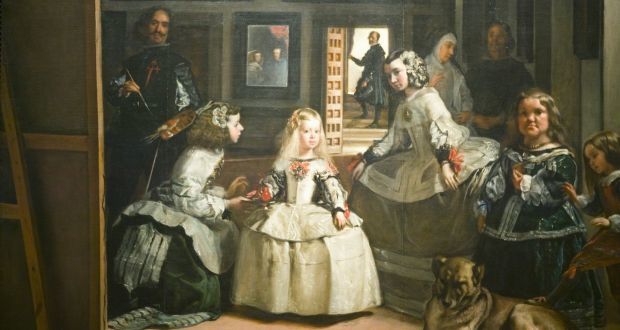
One of the most innovative artworks of its time, Las Meninas may not look particularly noteworthy to a contemporary viewer.
While Diego Velazquez’s earlier works were typical royal portraits, his painting of Las Meninas in 1656 marked a drastic break from those.
Pictures of the day, which previously would have only included members of the royal family, showed a lot more order and hierarchy.
In Las Meninas, however, the artist herself joins the usual suspects of a nun, a dwarf, and a princess.
Velazquez had more flexibility than most artists of his time because of his position as palace chamberlain at the Spanish royal court.
On display at Museo Nacional del Prado in Mardid, Spain.
9. Bal du moulin de la Galette – Pierre-Auguste Renoir
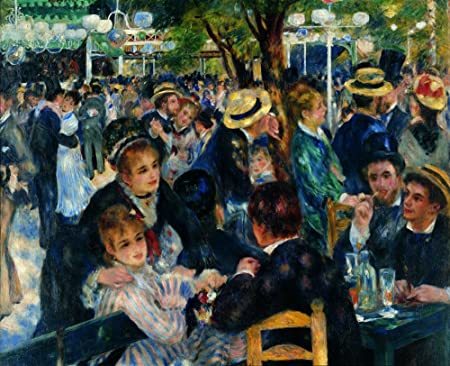
A famous picture by Pierre-Auguste Renoir, one of the greatest artists of the late 19th century, is one of the Musée d’Orsay‘s most popular pieces.
Renoir, an Impressionist painter famous for his depictions of Parisian high society, had a special gift for depicting the fashionable pastimes of the time.
The scenario is shown in a painting that has been hailed as one of the greatest Impressionist works of all time by both art historians and critics. Created in 1876, this piece shows what a regular Sunday at the Moulin de la Galette looked like.
Renoir and many of the other prominent artists of the Impressionist era would often gather here to socialize and discuss art.
This iconic work by Renoir is displayed as the centerpiece of the Musée d’Orsay’s Impressionist exhibition, and it showcases the artist’s command of light and shadow.
10. The Raft of the Medusa – Théodore Géricault
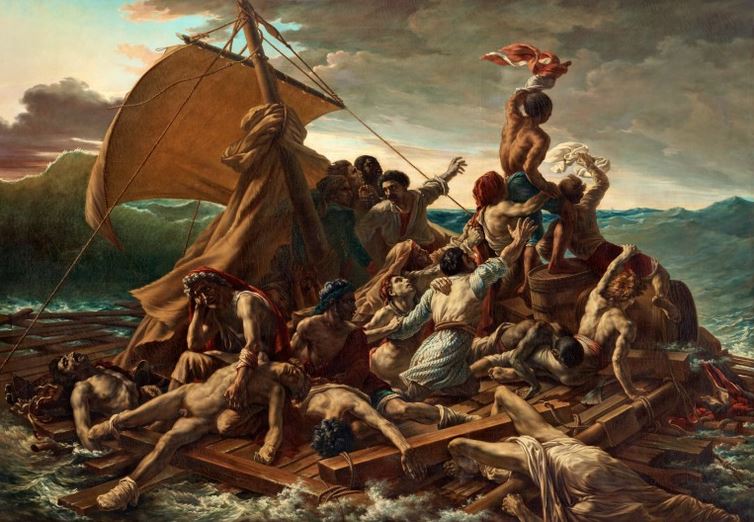
The Raft of the Medusa, by Theodore Géricault, is a masterpiece of French marine art. An 1816 shipwreck off the coast of Senegal serves as the inspiration for this piece, which is widely considered to be one of the finest examples of French Romanticism.
Before picking up a paintbrush, the artist did significant research on the tragedy and thought long and hard about how to depict the grim reality of being shipwrecked.
Géricault fabricated a scenario based on the experiences of two shipwreck survivors that was more optimistic than what had been published in the media at the time.
Survivors of the French Royal Navy ship claimed they were forced to eat each other due to infighting. The piece is predicated on the paradoxical mix of hope and fear one feels while shipwrecked.
A part of the permanent collection of the Louvre Museum in Paris, France.
11. Sistine Chapel Ceiling – Michelangelo
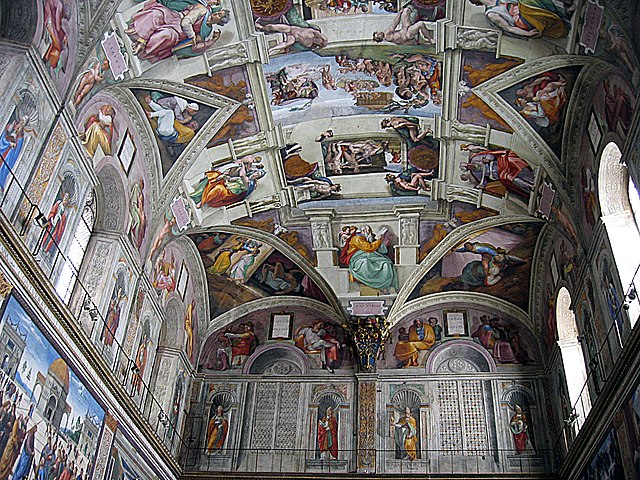
Although the entirety of the Sistine Chapel ceiling is more spectacular, Michelangelo’s The Creation of Adam, the chapel’s centerpiece, receives the most attention.
Between 1508 and 1512, Michelangelo painted the IVolta della Cappella Sistina (Sistine Chapel Ceiling). It is an excellent example of Renaissance art at its best.
Pope Julius II commissioned the mural on the ceiling. Even now, the chapel is used for papal conclaves and other major occasions.
Every one of the nine incidents represented there comes straight from the first chapter of the Bible, with the most famous being Adam’s creation.
Michelangelo’s mastery of the human form is on full show in this intricate pattern, which features groups of clothed and unclothed people in a wide variety of poses and has served as an invaluable source of inspiration for artists ever since.
Michelangelo painted the entire massive work while lying flat on his back, suspended from a scaffolding system he had set up in the ceiling.
12. Liberty Leading the People – Eugène Delacroix
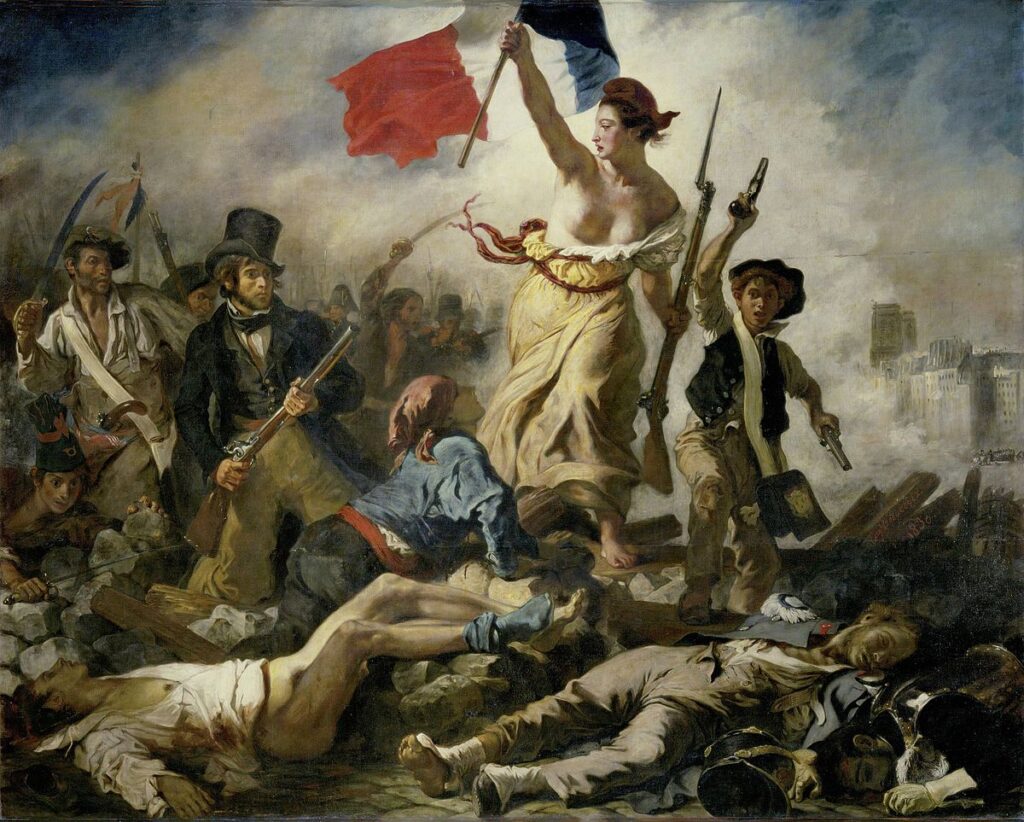
One of the bloodiest periods in European history was the French Revolution. The less well-known July Revolution took occurred in the summer of 1830, and it was marked by less murder but an outpouring of passion on the part of the French people in their quest to remove a monarch they considered as unworthy.
In the same year, Eugene Delacroix painted Liberation Leading the People to encourage the French people to keep working toward complete independence from the monarchy.
In the artwork, regular Frenchmen with muskets charge an enemy position. All eyes are drawn to the lovely female figure of Marianne, who stands in for the French Republic on their front.
She’s wearing something that only covers part of her body, and she’s holding a French flag and a weapon like she’s encouraging the troops to charge forward and defeat the king’s rebels.
To this day, it remains one of the most well-known paintings of the nineteenth century and one of the most recognizable French works of art.
It is a part of the permanent collection of the Louvre Museum in Paris, France.
13. Wheatfield with Crows – Vincent van Gogh
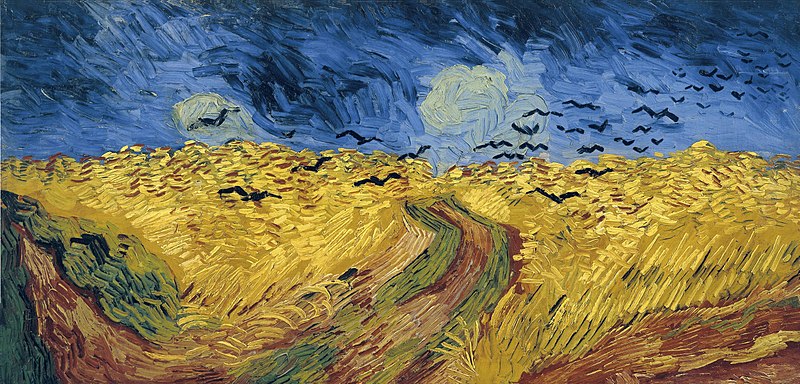
A longer canvas than regular van Gogh’s, depicting a dramatic, cloudy sky dense with crows above a wheat field. A wheat field whipped by the wind fills up the middle two-thirds of the canvas. The vacant path invites the viewer into the scene.
Supposedly painted by Van Gogh in July of 1890, Wheatfield with Crows is a popular subject among art enthusiasts. It’s not as well-known, but it’s widely acknowledged to be one of his finest pieces of work.
Many people think this was van Gogh’s final painting. Art historians debate which of van Gogh’s paintings was his last since they can’t be sure of any definitive historical documents.
In addition to Wheatfield Under Thunderclouds and Daubigny’s Garden, this is one of several paintings by van Gogh at the time that were executed on double-squared canvases (which he would paint three times).
All of these paintings are on the unusually long and narrow double-square canvases that van Gogh used only in the summer of 1890, during his final months.
Both this and Wheatfield under Clouded Sky are part of the Van Gogh Museum’s holdings in Amsterdam.
In 1991, twenty-one paintings by Van Gogh were stolen and then found, including Wheatfield with Crows. During the course of the theft, the artwork was “severely destroyed” by the robbers.
On display at Van Gogh Museum in Amsterdam, Netherlands.

